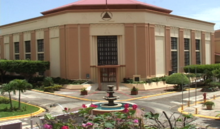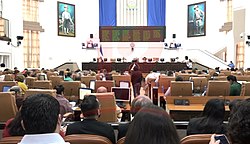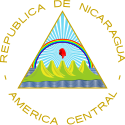|
National Assembly (Nicaragua)
The National Assembly (Spanish: Asamblea Nacional) is the legislative branch of the government of Nicaragua founded in January 1985. HistoryThe unicameral National Assembly replaced the bicameral National Congress of Nicaragua which was disbanded following the overthrow of Somoza government in 1979. There was an interim Council of State with 47 and later 51 appointed members from 1980 to 1984.[2] First elections to the National Assembly took place in November 1984, and the first National Assembly took legislative functions from the Junta of National Reconstruction on 10 January 1985.[1] Composition The Nicaraguan legislature is a unicameral body. It is made up of 92 deputies, 90 of whom are elected by popular vote on a proportional representation basis from party lists: 20 nationally, and 70 representing the country's departments and autonomous regions. In addition, the President of the Republic who served the immediately previous presidential term is entitled to sit in the Assembly as a deputy, as is the runner-up in the most recent presidential election. The President and the National Assembly serve concurrent five-year terms. To be eligible for election to the assembly, candidates must be (Art. 134, Constitution):
The following are disqualified from serving in the Assembly:
Four months before the Nicaraguan general election, 2016, the Nicaraguan Supreme Court removed PLI leader Eduardo Montealegre, decreeing that Pedro Reyes was the new leader of the PLI. After PLI and allied Sandinista Renovation Movement deputies objected, Nicaragua's Supreme Electoral Council ordered them removed from the National Assembly and empowered Reyes to select their replacements.[3] Election resultsDeputies as of June 21, 2021:[4]
Parliamentary groupsThe deputies are organized in Parliamentary Groups (bancadas). The current number of deputies of the parliamentary political parties is:
See also
Notes
References
External links
|
|||||||||||||||||||||||||||||||||||||||||||||||||||



